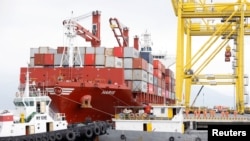The United States sent its second aircraft carrier in as many years to Vietnam this week, shortly after toughening up its treatment of the Southeast Asian country’s economic prowess over concerns about the bilateral trade imbalance. Vietnam went along with both moves, yet didn’t play up either.
Vietnam and the United States are growing closer, despite their bitter war 50 years ago, as both hope to check Beijing’s expansion in the South China Sea, analysts say. However, Vietnam’s communist political system and pursuit of a multicountry foreign policy rather than a purely pro-Western one are likely to stop Washington from getting too close.
For their part, U.S. officials worry about Vietnam’s U.S. trade surplus.
“Washington’s institutional bureaucracy surely sees Hanoi as a partner in pushing back against Beijing’s South China Sea claims and militarization,” said Sean King, vice president of the New York-based Park Strategies political consultancy, “but Vietnam’s not an ally, nor a democracy, hence there are limits to this partnership.”
“My sense is Vietnam wants [the United States] as a regional counterweight to Beijing but doesn’t want to be part of any wider U.S.-mainland Chinese containment strategy,” King said.
Aircraft carrier visits
On Thursday the USS Theodore Roosevelt aircraft carrier docked in the central Vietnamese city of Da Nang, military news website Stars and Stripes reported. A guided-missile cruiser accompanied the carrier on the ceremonial visit. The USS Carl Vinson, the first American aircraft carrier to visit since the Vietnam War, made a port call two years ago.
The visits show both sides intend to strengthen defense relations. Vietnam looks to outside support in keeping Chinese vessels away from South China Sea tracts it contests with China, which has a stronger military.
Vietnamese officials “are building a strategic trust between the two countries and they want to engage the U.S. more in the South China Sea,” said Nguyen Thanh Trung, Center for International Studies director at the University of Social Sciences and Humanities in Ho Chi Minh City. “I think that in the future Vietnam will be more welcoming of U.S. naval ships,” he said.
Vietnam and China got into a boat-ramming incident in 2014 over the placement of a Chinese oil rig. Last year the two sides entered a standoff near Vanguard Bank, a South China Sea feature where Vietnam was looking for energy.
China cites historical records to back its claim to about 90% of the sea, which covers 3.5 million square kilometers rich in fossil fuel reserves and fisheries. It has alarmed Vietnam and five other Asian governments by sending ships and by landfilling islets for military use.
Vietnam’s resistance against China caught the attention of former U.S. President Barack Obama, who in 2016 lifted a post-Vietnam War embargo on sales of lethal arms to Hanoi. Vietnam aside, the U.S. regularly sends warships into the South China Sea on “freedom of navigation operations” to warn China, which Washington sees as a rival superpower.
Vietnam doesn’t want to get too close militarily, said Carl Thayer, emeritus professor at the University of New South Wales in Australia.
Vietnamese media went low-key in covering the USS Theodore Roosevelt visit, Thayer said. Hanoi’s leaders are focused, he said, on a 7-year-old “comprehensive partnership” that covers cooperation beyond defense.
Vietnam trades briskly with China and keeps macro relations stable despite the maritime spats as part of a multicountry foreign policy. The Southeast Asian government has comprehensive strategic partnerships too with India and its old ally Russia.
Some conservatives in the Vietnamese government don’t want U.S. relations to grow “too fast,” Nguyen said.
Tougher on trade
The U.S. government’s Feb. 10 delisting of Vietnam as a “developing country” indicates a knottier bilateral trade relationship; the move gives Washington more clout to investigate whether Vietnamese export subsidies hurt U.S. industries.
Vietnam must now follow rules-of-origin guidelines on steel and footwear, business consultancy Dezan Shira & Associates says in a research note. U.S. officials, already nonplussed by a $47 billion bilateral trade deficit, worried last year about whether Chinese goods were being shipped through Vietnam to avoid U.S. tariffs.
Possibly to ease resentment in Washington, Vietnam agreed this week to buy $3 billion in American farm goods.
Vietnam’s lure of cheap labor has boosted export manufacturing over the past eight years. The country doesn’t need special treatment anymore, said Frederick Burke, partner with the law firm Baker McKenzie in Ho Chi Minh City.
“The benefits of moving up the ladder is that you no longer depend on handouts,” he said. “You have real investors deeming Vietnam to be one step better in terms of investment grade, so people will come here out of their own private sector motives, and it’s more of a natural thing instead of having to be on life support like some least-developed countries.”
However, Vietnam hopes never to become “vulnerable to U.S. pressure to open up politically,” King said.












